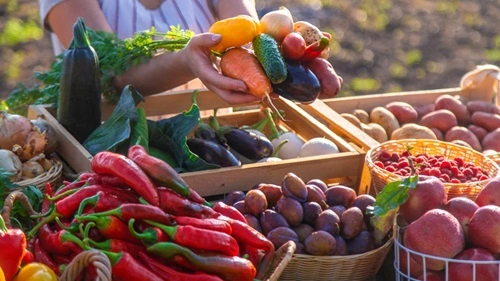Vegetable farming is a significant contributor to India’s agricultural industry. In recent times advancements in technology, improved farming techniques, and strategic government support have contributed towards improvement in vegetable farming in India. As the demand for fresh produce increases both domestically and internationally, certain states have emerged as leaders in vegetable farming in India. The states make a significant contribution to the country’s vegetable production by utilizing their natural resources such as fertile land, rainfall and farming techniques.

1. Uttar Pradesh
Uttar Pradesh is leading in vegetable farming in India. It contributes to nearly 14.8 per cent of the country’s total vegetable production. The state’s large rural population is heavily involved in agriculture, contributing significantly to the country’s vegetable output. UP enjoys favourable agro-climate conditions, strong irrigation facilities and robust infrastructure that supports vegetable farming in UP. The state grows a variety of vegetables including peas, chillies, okra, tomato, brinjal, cauliflower, cabbage, radish, spinach and melon. The government’s agricultural support programs and improved irrigation infrastructure have further bolstered production.
2. West Bengal
The next state on our list of most vegetable-producing states in India is West Bengal. West Bengal contributes to around 12-14 per cent of India’s vegetable output. The state’s favourable climate, fertile soil, and availability of water from the Hooghly River and its deltaic region provide optical conditions for year-round vegetable cultivation. Major vegetables that are cultivated in West Bengal are potatoes, cauliflower, cabbage, brinjal and green peas. Potato is vastly grown in West Bengal. The state vegetable farming has also benefitted from a well-developed irrigation system, an efficient transport network and proximity to major markets, domestic and international.
3. Maharashtra
The next state on our list of largest vegetable-producing states in India is Maharashtra. Similar to previous states, Maharashtra also benefits from fertile soil and well-developed irrigation facilities. Nashik, Pune and Ahmednagar of Maharashtra grow the highest number of vegetables in the state. Maharashtra vegetable farmers use precision farming techniques, crop protection methods and market-oriented approaches that ensure high-quality produce. A variety of vegetables grown in Maharashtra is onions, tomatoes, brinjal, cabbage and cauliflower. The state is the highest producer of onions in India; it amounts to 25 per cent of the country’s total onion production.
4. Bihar
Bihar is the fourth largest producer of vegetables in India. The state’s favourable agro-climatic conditions and an increasing focus on horticulture have pushed it to the forefront of vegetable cultivation. Bihar has seen substantial government investments in agricultural infrastructure, including better irrigation facilities, cold storage units, and farmer training programs. These have contributed to improved yields and higher production efficiency. The districts of Bihar that focus on vegetable cultivation are Patna, Nalanda, Vaishali, Muzaffarpur, West and East Champaran and Begusarai. Some of the vegetables grown in Bihar are Potatoes, brinjal, cabbage, cauliflower, tomatoes, and okra. It contributes about 8-9 per cent of India’s vegetable production. Bihar has a particular focus on high-yield crops like potatoes and brinjal.
5. Andhra Pradesh
Andhra Pradesh holds fifth place in the production of vegetables in India. It is a major producer of fruits and vegetables in India and plays a significant role in the country’s horticulture sector. The state produces many vegetables such as tomatoes, brinjals, okra, beans, onions and chillies. Vegetable farming is high in Andhra Pradesh due to suitable climate conditions, irrigation infrastructure and support from private investments. The state government encourages farmers to grow vegetables as it is climate resilient and can ensure higher income for the farmers.
In Conclusion
India’s top vegetable-producing states are the backbone of the country’s agricultural economy. These states ensure a continuous supply of fresh produce mainly vegetables for domestic consumption and export. Vegetable farming is resilient and it bounces back from challenges and ensures efficient contribution to the economy. These states have efficiently used their natural resources, government policies and modern farming techniques to maintain and increase their production. As India continues to prioritize agriculture, particularly horticulture, these states will remain pivotal in driving the country’s vegetable production forward in 2025 and beyond.
Parkash Singh is a PGT Teacher in Kendriya Vidyalaya Rohini, New Delhi. Parkash completed his starting education from Bihar Board and graduated from Babasaheb Bhimrao Ambedkar Bihar University. He regularly writes educational and informative articles at IndiasStuffs.com
Page Contents

